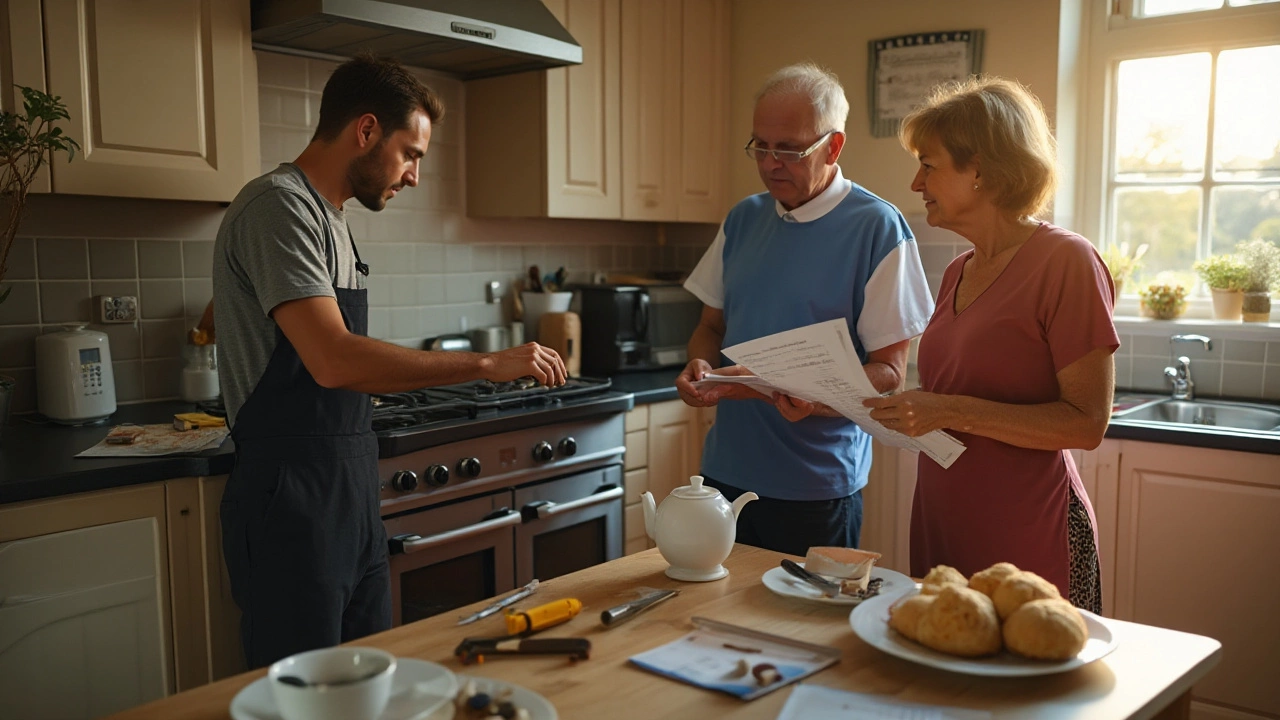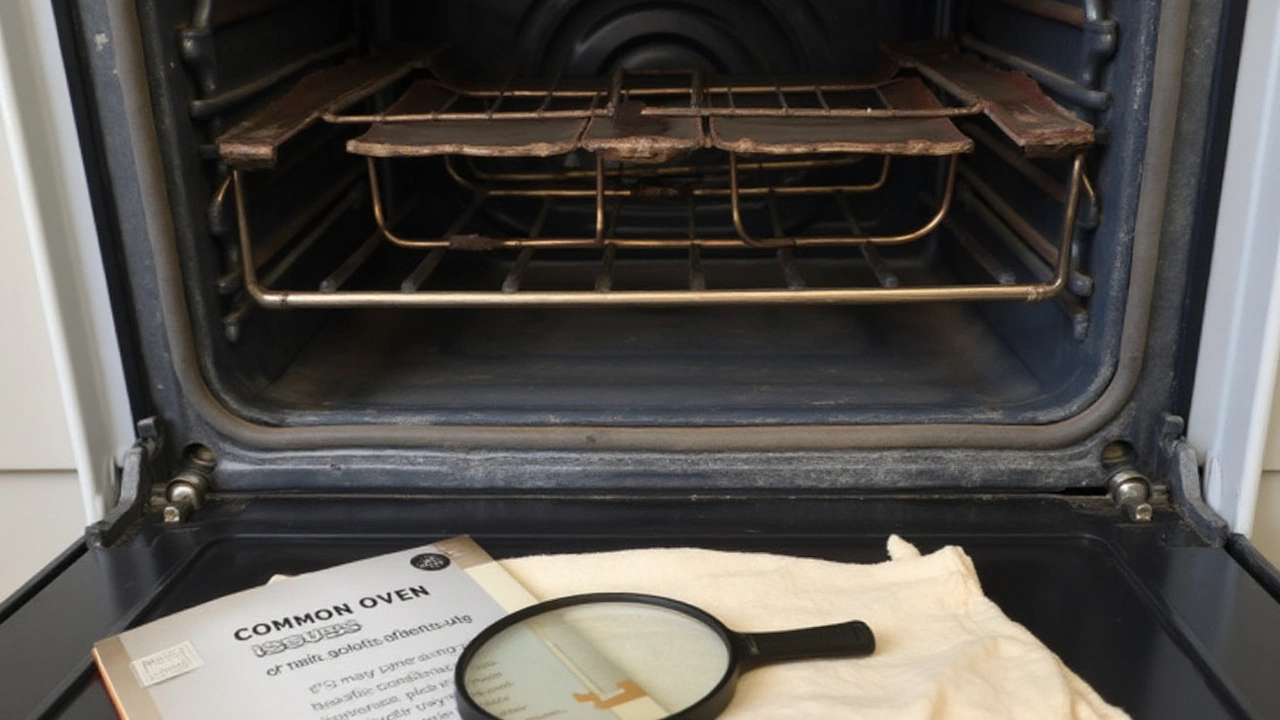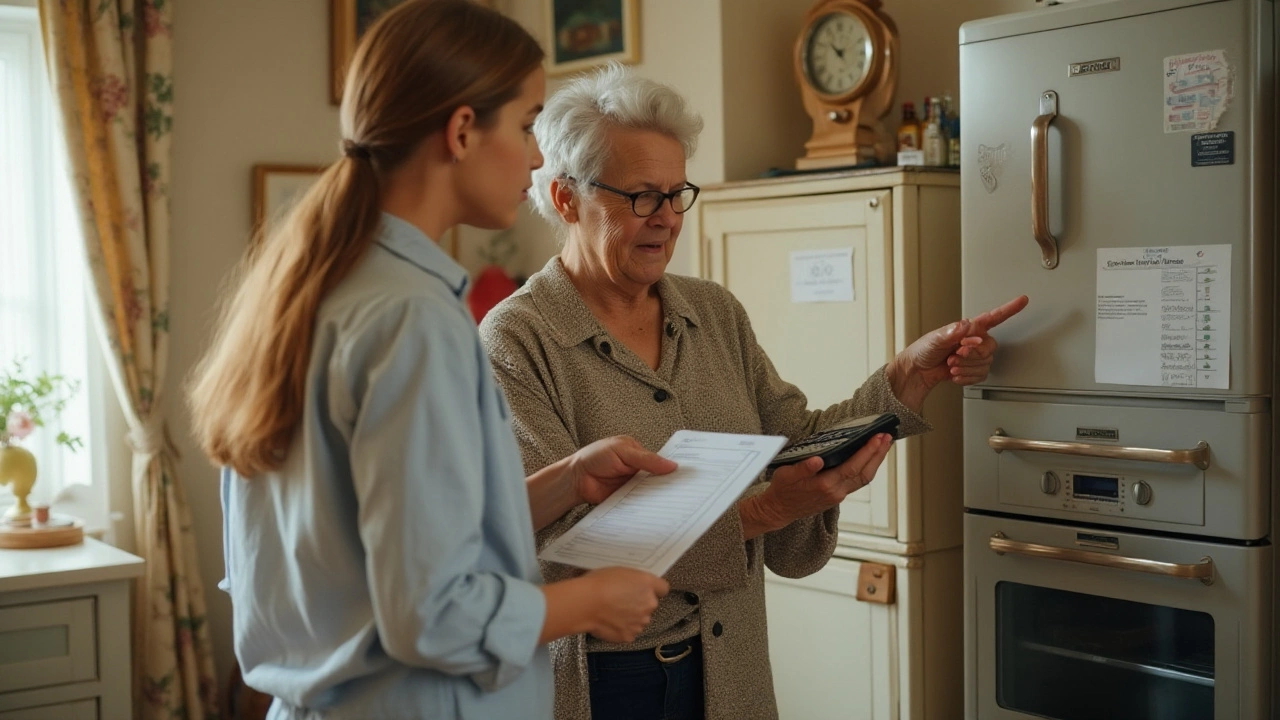Is Repairing a Five-Year-Old Electric Oven Worth the Investment?
 Oct, 19 2024
Oct, 19 2024
When your trusted oven shows signs of wear after five years of service, the burning question of whether it's time to repair or replace surfaces.
An electric oven is an essential kitchen companion, and its sudden malfunction can disrupt your culinary routine. As you weigh the options, understanding your oven's current issues and knowing repair costs are essential. Sometimes, a quick fix keeps your appliance running just fine while saving you money.
Explore the nuances of maintaining your oven's health, extending its lifespan, and deciding when investing in a new one might be the wiser choice. This journey through common repairs, financial considerations, and sustainable choices empowers you to act with foresight.
- Understanding Common Oven Problems
- Evaluating Repair Costs
- Tips to Maintain Your Oven
- Signs It Might Be Time to Replace
- The Environmental Impact of Repair vs. Replace
- Making the Financial Decision
Understanding Common Oven Problems
Having a five-year-old oven start acting up can be quite unsettling, especially when every kitchen confidence rides on it being reliable. There are a variety of problems that can crop up as your electric oven ages, each with its quirks and symptoms. Recognizing these can be a crucial first step in knowing whether a simple repair can bring your oven back to life, or if it's part of a more serious defect.
One of the primary issues owners encounter is a situation where the oven isn’t heating up to the desired temperature, or worse, not heating at all. This often stems from a faulty heating element or a thermostat that’s seen better days. Spotting uneven cooking or items taking much longer than usual to bake perfectly could suggest the element isn't as efficient anymore.
Another common hiccup is temperature inconsistency; your oven might cycle between getting blisteringly hot or becoming too cold during the middle of a cooking session. The possible culprit might be a malfunctioning temperature sensor or a miscalibrated temperature gauge. Steam escaping from unexpected places, ovens that won't self-clean, or doors that won't latch securely can all indicate subtle age-related wear and tear. In fact, a Consumer Reports survey noted that electric ovens have a repair rate of 20% in their first five years, shedding light on potential issues during this period.
Electrical problems shouldn't be overlooked either. From the display error to a completely non-functioning control board, electrical faults can be daunting for the uninitiated. If an oven is consistently tripping the circuit breaker, it may be drawing too much power due to an internal issue. A diagnostic look with a multimeter by a professional can easily determine if it's a pesky short or something indicative of the larger component failure.
"Regular maintenance can significantly reduce the number of unexpected repairs," advises Sarah Reiners, an appliance expert at The Home Appliance Network.
Cosmetic issues, while not affecting performance, often signal the beginnings of underlying issues. Rust forming around the door seal or inside the cavity can be a red flag. This could happen because of moisture buildup, which over time, also leads to a more serious condition – electronic component failure due to corrosion. Smoke and odd smells emanating from the oven can also lead back to this problem and necessitate an inspection of door gaskets and seals.
Data from Reliable American Appliance Repair reveals that older ovens, particularly five-year or older models, are more susceptible to these complications, driving the narrative that routine checks and basic maintenance like cleaning can prolong the appliance's lifespan significantly. Recognizing and addressing these evident common issues not only revitalizes an old oven but ensures your investment doesn’t surprise you with burdensome repair bills unexpectedly. The better we understand these issues, the smarter our repair decisions can be, assuring that the culinary heart of the home beats smoothly again.
Evaluating Repair Costs
Repairing your electric oven involves more than just the initial expense; it includes a thoughtful evaluation of the appliance's condition, the nature of the problem, and the implications of the repair. At five years old, many ovens start to experience some common issues, like faulty heating elements, broken thermostats, or unresponsive control panels. Each problem varies in complexity, which is reflected in the repair cost. Understanding these dynamics helps in making a financially sound decision on whether to proceed with a repair.
The first step in estimating repair costs is identifying the issue affecting your oven. For example, a malfunctioning heating element, a typical problem in five-year-old ovens, usually sets you back around $100 to $200 when considering parts and labor. On the other hand, issues with the control board might surge to $300 or more, depending on the brand and model of your appliance. Knowing these figures helps you weigh the repair expense against the oven's remaining lifespan. Importantly, it's crucial to compare these costs with the expenditure of acquiring a new model, which could range between $500 to several thousands, depending on the specifications you're eyeing.
"The lifespan of most electric ovens can extend up to 15 years with proper care," notes a study by the National Appliance Service Convention. "However, frequent problems after the five-year mark indicate the appliance's components are beginning to degrade, potentially leading to higher maintenance costs."
While considering repair costs, take the opportunity to reflect on energy efficiency improvements. Many newer ovens offer superior energy efficiency compared to older models. If the cost of repairing approaches or exceeds half the price of a new oven, upgrading might be a prudent long-term investment. Energy savings achieved with a new model can often offset initial expenses through lower utility bills.
For those wanting to dive deeper into financial insights, evaluating potential savings and repair costs can be assisted by examining data and statistics regarding appliance lifespan and maintenance costs. This holistic approach to understanding whether to repair or replace empowers you to keep your kitchen running efficiently, all while ensuring that your decision aligns with your financial and environmental values.

Tips to Maintain Your Oven
Ensuring the longevity and efficiency of your electric oven starts with consistent maintenance practices. This not only keeps your oven in top condition but also helps avoid unexpected repair costs. Simple steps like routinely cleaning spills and residue can go a long way. A mixture of baking soda and water often works wonders for grime removal. It's useful to perform a thorough cleaning at least once every three months. This ensures that all parts remain in working order, reducing strain on the components.
Keeping an eye on the oven's seals is another crucial step. The door seal keeps heat from escaping during cooking, maintaining the oven's efficiency and temperature accuracy. If you find it cracked or loose, replacing it can save energy costs in the long run. Regularly inspect the seals by running a hand around the edges and feeling for escaping heat, which indicates the need for attention.
An often overlooked aspect is the careful handling of oven racks. Taking these out slowly and avoiding force ensures that they maintain their shape and function. If they seem hard to slide, a bit of lubrication with cooking oil can ease the movement. When cooking, avoid slamming the oven door, as this minor act can misalign components over time. Remember, the little actions help maintain the appliance's durability.
Electric oven maintenance also involves ensuring proper ventilation. Blockages in or around the vents can lead to overheating and inefficient cooking. Frequently check and clear vents from any obstructions, which not only prolongs your oven's life but also improves its performance. Also, avoid placing foil on the bottom of the oven as it can block airflow and damage the interior.
Don't neglect the importance of keeping your oven's calibration in check. Using an oven thermometer, compare the internal temperature against the setting. Adjust if needed, and consider calling a professional if inaccuracies persist, as this may indicate deeper issues. As a well-known chef once said,
"An oven properly calibrated is the hidden treasure of every kitchen."Adhering to these steps ensures your trusty appliance serves you well for years, delivering the delectable results you expect each time.
Signs It Might Be Time to Replace
An oven can often accumulate a series of issues due to regular wear and tear over five years of use. When repair costs start cutting too deeply into your wallet, it might be worth considering the option to replace rather than persist with an aging oven. Striving to keep a failing unit running can rapidly turn into a costly endeavor if multiple components start to malfunction or exhibit signs of failure. Consistently requiring attention for issues like uneven heating, faulty thermostats, or unresponsive buttons indicates that the end of your oven's useful life may be near. Besides, when you find yourself treading common ground with Hopkins' rule of thumb, most standard ovens last approximately 13 to 15 years, providing they are well-maintained. However, if components like the heating element or electric control board see constant repairs, it might not last that long. This is your signal to assess the state of your oven. If addressing mechanical hiccups seems like a regular activity, controlled replacement should be an option to weigh in.
Frequent power fluctuations or erratic temperature adjustments leech efficiency from your oven and trust from your cooking process. Have your culinary masterpieces suffered inconsistent baking despite pre-calibration? Unfortunately, unreliable ovens create a friction between you and your culinary creativity and are often not worth salvaging after numerous repairs. It climbs further up the "replace ladder" when you consider reducing your carbon footprint – newer models of electric ovens passed the Energy Star test, proving themselves as energy-efficient alternatives.
| Feature | Old Model | New Model |
|---|---|---|
| Energy Usage | 2.4 kwh | 1.5 kwh |
| Lifespan | 6-10 years | 10-15 years |
It's not all about mechanical wear - sometimes the needs of your house and routine simply outgrow your once-treasured appliance. For families where ovens see heavy usage beyond casual dinners, advanced models with additional functions become more than just a luxury; they redefine family cooking. If time-saving features like programmable timers, smart connectivity, or advanced self-cleaning are calling out to you, this is your cue to contemplate upscaling. With contemporary smart ovens offering settings that integrate with home automation systems, the leap towards replacement is not purely an economic evaluation, but also about aligning technology with lifestyle goals.
"Replacing an appliance isn't solely about fixing broken parts but embracing the potential for improved efficiency and convenience," notes Sarah Browning, home appliance consultant. Hastings Energy Solutions concurs, reporting that appliances beyond ten years result in increased energy bills due to efficiency penalties.
Safety is the cornerstone of any kitchen decision, and a five-year-old oven displaying dangerous defects becomes a candidate for retirement. Consider the scenario: flickering digital screens or getting slight shocks on contact should act as red flags. Old wiring circuits, compromised over time, can put your home at risk through electric arcing or triggers for potential fires. Remember, while short-term monetary relief might tempt you into persisting with repairs, safety concerns warrant immediate action. Weighing fiscal prudence against the potential for home safety, a strategic upgrade not only enhances the safety of your culinary space but also extends to safeguarding family well-being. It's about replacing redundancy with effectiveness, as much as ensuring that your beloved family gatherings transpire smoothly and joyously with a reliable oven at center stage.

The Environmental Impact of Repair vs. Replace
Every time we consider whether to repair or replace an electronic appliance like an electric oven, the decision stretches beyond our wallets. This choice carries weight for our environment too, often more than we might initially think. A repair can seem like the obvious eco-friendly option. By prolonging the life of an existing item, we conserve resources that would otherwise be spent on manufacturing a new unit. This means less mining for materials and less energy consumption in factories where appliances are made.
Discarding any appliance has its own environmental toll. Electronic waste, or e-waste, constitutes a growing problem globally, with millions of tons discarded each year. When appliances are dumped in landfills, they can leak harmful substances into the soil and water, contributing to pollution. Repairing your oven avoids adding another item to these rising heaps of e-waste. It encourages the use of local repair services, which not only supports businesses but often reduces the carbon footprint associated with transporting new goods extensively.
On the flip side, there are times when replacing may be the environmentally wiser choice. Modern appliances tend to be more energy-efficient, adhering to advanced green standards. An older oven might consume more electricity, leading to increased fossil fuel use and a larger carbon footprint over time. Manufacturers are increasingly focused on sustainability, using recyclable materials or renewable energy sources in production, which can sometimes justify the environmental cost of replacing an older, less efficient model.
Regarding the broader lifecycle impact, a study done by Toasterwise suggested that extending the life of household appliances by just one year could prevent the release of over 47 million tons of carbon dioxide globally.
"Choosing to repair over replacing often yields a net positive environmental benefit," remarks David Greening, leading advocate for sustainable living.It's crucial to evaluate your specific situation: the efficiency of your current oven, potential improved efficiency with a new unit, and the local options for recycling parts.
Finally, understanding what happens after an appliance is replaced helps the decision. Many companies now offer take-back schemes, ensuring that old units are refurbished or recycled properly, greatly reducing environmental impact. Check for these programs to make the greenest choice possible.
Being mindful about our appliances means more than reducing e-waste; it contributes to the collective effort to use our planet's resources wisely and efficiently. Consider all these factors the next time your electric oven starts acting up, and you'll be making a choice that benefits not just your kitchen, but the world we all share.
Making the Financial Decision
When faced with the option of repairing a five-year-old electric oven or purchasing a new one, numerous angles need evaluation. The first step in this journey is to understand the gravity of the repair. Most ovens face issues such as faulty heating elements, broken thermostats, or failing power supplies. Each problem comes with its distinctive repair cost, but it's often the labor that can inflate the price. On average, repairing a electric oven can range from $100 to $400, depending on the complexity of the issue. If your repair estimate edges towards the higher end, you're inching closer to the price of a new mid-range oven, which can open the doors to other possibilities.
Consider the warranty as a potential cornerstone in this decision-making process. Many ovens come with a guarantee of at least five years, covering certain repairs and parts. It's not uncommon for homeowners to overlook these warranties, thus missing out on cost-saving opportunities. Call the manufacturer or check your paperwork to see if your oven repair might be covered. Additionally, think about the frequency and nature of past repairs. Have you been constantly calling the technician, or has it been mostly smooth sailing? A recurring issue might hint at underlying problems that a mere repair might not solve in the long run.
A noteworthy element is the energy efficiency mode of your current oven. Over the years, advancements in technology have gifted newer ovens with more energy-efficient components. According to the U.S. Department of Energy, modern appliances can reduce energy consumption by up to 30% compared to older versions. Ask yourself if your old faithful still meets these evolving standards. Converting to a new oven can equate to prominent energy savings, which, while not immediately evident, accumulates into a refreshed bank account over time.
Sometimes it's helpful to look beyond the immediacy of repair costs and examine the broader financial picture. There's the value aspect; an upgraded appliance can heighten your home's worth if you're considering selling it soon. Plus, many regions offer rebates or tax incentives for those who invest in energy-efficient appliances. While the dilemma of repairing or replacing whispers financial echoes, weighing these broader implications allows for informed decision-making.
"Appliance longevity and repair frequency are essential. Understand the manufacturer's maintenance schedule," advises Allan Cybulski, Senior Home Economics Editor of "Home & Hearth" magazine.
The final choice rests on a constellation of personal factors; your attachment to your current oven, the layout of your kitchen, and financial flexibility. A practical guide can be crafting a pro and con chart that marks these features against repair versus replacement. Then, consider the long-term financial advantages of investing in a new model balanced against the upfront, immediate savings of a repair.
In the end, whether it's staying loyal to your five-year-old oven or embarking on a new purchase journey, the decision should harmonize with both your wallet and lifestyle needs. Every repair or replacement story is unique, driven by distinctive priorities and expectations. As you sit down and sift through the details, ensure your choice resonates with your household’s culinary adventures and financial aspirations.
